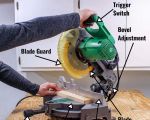Best Saws for Cutting Laminate Flooring: A Complete Guide
Laminate flooring has become a popular choice for homeowners due to its affordability, durability, and attractive appearance. However, cutting laminate flooring can be tricky without the right tools. Whether you're a professional contractor or a DIY enthusiast, choosing the best saw for cutting laminate flooring is essential for a clean, precise cut. In this article, I'll walk you through the best saws available, provide tips on how to use them effectively, and share some valuable insights on how to make your cutting process smoother.
1. Why Cutting Laminate Flooring Requires a Specific Type of Saw
When it comes to cutting laminate flooring, it's important to understand the material. Laminate is a composite material made up of several layers. The top layer is a photographic film that simulates wood, stone, or tile, which makes it prone to chipping and splintering during cutting. This is why you need a saw that can handle the material with minimal damage. A clean cut is necessary for both aesthetics and the overall installation process.
2. Best Types of Saws for Cutting Laminate Flooring
There are a variety of saws available for cutting laminate flooring. However, not all are created equal. Below, I’ll highlight some of the best saws for this job, keeping in mind factors like precision, ease of use, and cost-effectiveness.
2.1 Circular Saws
Circular saws are one of the most popular choices for cutting laminate flooring, especially when you need to make long, straight cuts. Equipped with a fine-toothed blade, a circular saw can produce smooth cuts while minimizing splintering. You can use a circular saw with a guide or fence for added accuracy.
Pro Tip: To get the best results, use a blade designed specifically for laminate or a carbide-tipped blade to reduce the risk of chipping.
2.2 Jigsaws
If you're looking for more versatility and need to make curved or irregular cuts, a jigsaw is a great option. It allows you to cut intricate shapes with ease. However, jigsaws can sometimes leave rough edges, so it’s important to use the right blade—preferably a fine-toothed blade that’s suitable for laminate.
Pro Tip: Before starting, place a piece of painter’s tape on the cut line to reduce the chances of splintering during cutting.
2.3 Miter Saws
Miter saws are ideal for making precise, straight cuts, especially when you're working on corners or trim pieces. They offer better accuracy than a circular saw and are perfect for crosscuts, which is useful when cutting laminate planks to fit a room's size.
Pro Tip: When using a miter saw, ensure that the blade is sharp and specifically made for laminate or wood, as this will yield the cleanest cuts.
2.4 Table Saws
Table saws are another excellent option for cutting laminate flooring. They are highly accurate, making them great for rip cuts. A table saw’s fence ensures straight, consistent cuts, and it can easily handle thicker planks. However, table saws are bulkier and may require more space in your workshop.
Pro Tip: For the cleanest cut, ensure that the table saw’s blade is aligned properly and use a fine-tooth or carbide-tipped blade.
3. Factors to Consider When Choosing the Best Saw
When selecting a saw for cutting laminate flooring, several factors can influence your decision. Here are the main things you need to consider:
- Blade Type: As mentioned earlier, the blade is crucial. A fine-toothed blade is often the best choice for laminate flooring to minimize splintering.
- Power and Speed: Higher-powered saws may offer faster cutting speeds, but for laminate, you need a saw that can handle delicate cuts without overwhelming the material.
- Portability: If you’re working on multiple jobs or need to move the saw around, portability can be a key consideration.
- Precision: Precision is essential in laminate flooring installation, so choose a saw that allows you to make accurate cuts, whether it’s through a guide or a laser line.
4. Common Mistakes to Avoid When Cutting Laminate Flooring
Cutting laminate flooring isn’t difficult, but a few mistakes can cause frustration and wasted materials. Here are some common mistakes to avoid:
- Not Using the Right Blade: Always use a blade designed for laminate or wood to get the cleanest cuts.
- Cutting Without a Guide: Cutting freehand can lead to uneven cuts. Always use a guide or fence to ensure precision.
- Rushing the Process: Rushing can lead to mistakes like uneven cuts or splintering. Take your time and double-check measurements before making cuts.
5. My Personal Experience with Cutting Laminate Flooring
When I first tackled a laminate flooring installation project in my home, I was nervous about cutting the planks. I had heard horror stories about splintering and uneven cuts. However, after doing some research, I decided to use a circular saw with a fine-tooth blade, and it made all the difference. The cuts were smooth, and the installation process was much easier than I expected.
Since then, I’ve used a variety of saws for different laminate flooring projects. Each tool has its pros and cons, but if you’re looking for versatility and portability, I highly recommend a circular saw or a jigsaw, depending on the types of cuts you need to make. For precision, a miter saw is fantastic, and if you have a dedicated workspace, a table saw is an absolute game-changer.
6. Conclusion: Choosing the Best Saw for Your Laminate Flooring Project
Finding the best saw for cutting laminate flooring comes down to the type of cuts you need to make, the tools you already have, and the level of precision you require. Whether you’re using a circular saw, jigsaw, miter saw, or table saw, choosing the right blade and working carefully will ensure that your laminate flooring installation is smooth and professional-looking.
If you're still unsure about which saw to choose, visit us at ToolNest for a range of saws that will make your laminate flooring project a breeze.









